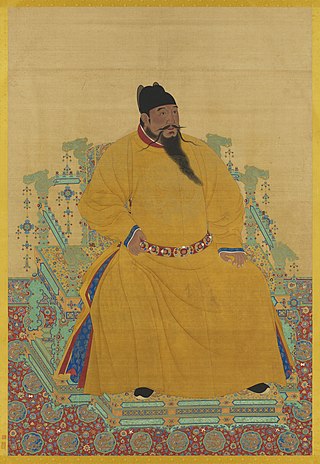Related Research Articles

The 15th century was the century which spans the Julian dates from 1 January 1401 to 31 December 1500 (MD).
Year 1403 (MCDIII) was a common year starting on Monday of the Julian calendar.
Year 1421 (MCDXXI) was a common year starting on Wednesday of the Julian calendar.
The 1380s was a decade of the Julian Calendar which began on January 1, 1380, and ended on December 31, 1389.
The 1360s was a decade of the Julian Calendar which began on January 1, 1360, and ended on December 31, 1369.

Year 1394 (MCCCXCIV) was a common year starting on Thursday of the Julian calendar.
The 1420s decade ran from January 1, 1420, to December 31, 1429.
The 1410s decade ran from January 1, 1410, to December 31, 1419.
The 1390s was a decade of the Julian Calendar which began on January 1, 1390, and ended on December 31, 1399.
The 1370s was a decade of the Julian Calendar which began on January 1, 1370, and ended on December 31, 1379.
Year 1377 (MCCCLXXVII) was a common year starting on Thursday of the Julian calendar.
Year 1407 (MCDVII) was a common year starting on Saturday of the Julian calendar.
Year 1408 (MCDVIII) was a leap year starting on Sunday of the Julian calendar.
Year 1411 (MCDXI) was a common year starting on Thursday of the Julian calendar.
Year 1414 (MCDXIV) was a common year starting on Monday of the Julian calendar.
Year 1419 (MCDXIX) was a common year starting on Sunday of the Julian calendar.
Year 1443 (MCDXLIII) was a common year starting on Tuesday of the Julian calendar.

The Yongle Emperor, personal name Zhu Di, was the third emperor of the Ming dynasty, reigning from 1402 to 1424.
The 1400s ran from January 1, 1400, to December 31, 1409.

The Ming dynasty considered Tibet to be part of the Western Regions. While the Ming dynasty at its height had some degree of influence in Tibet, the exact nature of their relations is under dispute by modern scholars. Analysis of the relationship is further complicated by modern political conflicts and the application of Westphalian sovereignty to a time when the concept did not exist. The Historical Status of China's Tibet, a book published by the People's Republic of China, asserts that the Ming dynasty had unquestioned sovereignty over Tibet by pointing to the Ming court's issuing of various titles to Tibetan leaders, Tibetans' full acceptance of the titles, and a renewal process for successors of these titles that involved traveling to the Ming capital. Scholars in China also argue that Tibet has been an integral part of China since the 13th century and so it was a part of the Ming Empire. However, most scholars outside China, such as Turrell V. Wylie, Melvin C. Goldstein, and Helmut Hoffman, say that the relationship was one of suzerainty, Ming titles were only nominal, Tibet remained an independent region outside Ming control, and it simply paid tribute until the Jiajing Emperor, who ceased relations with Tibet.
References
- ↑ Arthur Hassall (1919). France, Mediaeval and Modern: A History. Clarendon Press. p. 64. ISBN 978-0-598-86435-2.
- ↑ Keith Dockray (2004). Henry V. Tempus. p. 185. ISBN 978-0-7524-3046-1.
- ↑ Guzmán, L. (February 14, 2019). "Encuentran registros de megaterremoto ocurrido hace seis siglos en el norte de Chile". El Mercurio (in Spanish). Santiago, Chile. Retrieved June 8, 2019.
- ↑ Manuel Abad, Tatiana Izquierdo, Miguel Cáceres, Enrique Bernárdez and Joaquín Rodríguez-Vidal (2018). Coastal boulder deposit as evidence of an ocean-wide prehistoric tsunami originated on the Atacama Desert coast (northern Chile). Sedimentology. Publication: december, 13th, 2018. https://doi.org/10.1111/sed.12570
- ↑ Lily Xiao Hong Lee, Sue Wiles: Biographical Dictionary of Chinese Women, Volume II: Tang Through Ming 618 - 1644
- ↑ The Encyclopedia Americana. Grolier Incorporated. 1999. p. 516. ISBN 978-0-7172-0131-0.
- ↑ Anne Commire (October 8, 1999). Women in World History. Gale. p. 361. ISBN 978-0-7876-4061-3.
- ↑ Iris Lilian Whitman (1927). Longfellow and Spain. Lancaster Press Incorporated. p. 214.
- ↑ Dek, A.W.E. (1970). Genealogie van het Vorstenhuis Nassau (in Dutch). Zaltbommel: Europese Bibliotheek. p. 66.
- ↑ James Grant Wilson (1876). From Thomas the Rhymer to Richard Gall. Harper & brothers. p. 8.
- ↑ Henrik Birnbaum; Michael S. Flier (1984). California Slavic Studies. University of California Press. p. 60. ISBN 978-0-520-08638-8.